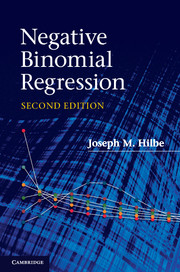Book contents
- Frontmatter
- Contents
- Preface to the second edition
- 1 Introduction
- 2 The concept of risk
- 3 Overview of count response models
- 4 Methods of estimation
- 5 Assessment of count models
- 6 Poisson regression
- 7 Overdispersion
- 8 Negative binomial regression
- 9 Negative binomial regression: modeling
- 10 Alternative variance parameterizations
- 11 Problems with zero counts
- 12 Censored and truncated count models
- 13 Handling endogeneity and latent class models
- 14 Count panel models
- 15 Bayesian negative binomial models
- Appendix A Constructing and interpreting interaction terms
- Appendix B Data sets, commands, functions
- References and further reading
- Index
1 - Introduction
Published online by Cambridge University Press: 05 June 2012
- Frontmatter
- Contents
- Preface to the second edition
- 1 Introduction
- 2 The concept of risk
- 3 Overview of count response models
- 4 Methods of estimation
- 5 Assessment of count models
- 6 Poisson regression
- 7 Overdispersion
- 8 Negative binomial regression
- 9 Negative binomial regression: modeling
- 10 Alternative variance parameterizations
- 11 Problems with zero counts
- 12 Censored and truncated count models
- 13 Handling endogeneity and latent class models
- 14 Count panel models
- 15 Bayesian negative binomial models
- Appendix A Constructing and interpreting interaction terms
- Appendix B Data sets, commands, functions
- References and further reading
- Index
Summary
What is a negative binomial model?
The negative binomial regression model is a truly unusual statistical model. Typically, those in the statistical community refer to the negative binomial as a single model, as we would in referring to Poisson regression, logistic regression, or probit regression. However, there are in fact several distinct negative binomial models, each of which are referred to as being a negative binomial model. Boswell and Patil (1970) identified 13 separate types of derivations for the negative binomial distribution. Other statisticians have argued that there are even more derivations. Generally, those who are using the distribution as the basis for a statistical model of count data have no idea that the parameterization of the negative binomial they are employing may differ from the parameterization being used by another. Most of the time it makes little difference how the distribution is derived, but, as we shall discover, there are times when it does. Perhaps no other model has such a varied pedigree.
I will provide an outline here of the intertwining nature of the negative binomial. Unless you previously have a solid background in this area of statistics, my overview is not likely to be completely clear. But, as we progress through the book, its logic will become evident.
- Type
- Chapter
- Information
- Negative Binomial Regression , pp. 1 - 14Publisher: Cambridge University PressPrint publication year: 2011



